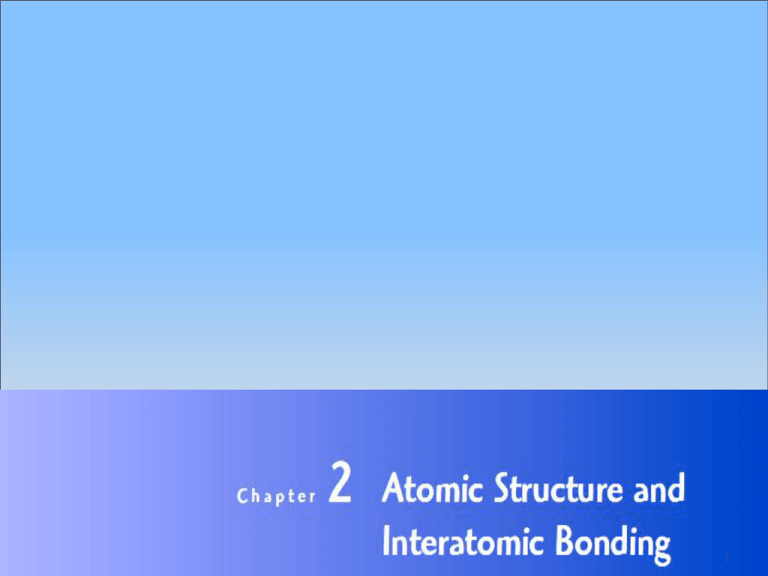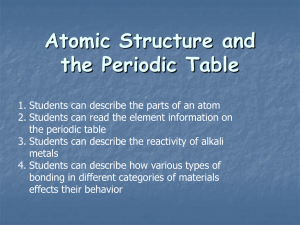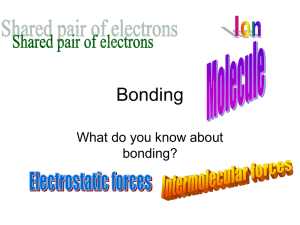Atomic Structure
advertisement

1 Fundamental Concepts Electrons: -ve Protons : +ve Neutrons: neutral Chapter 2: Atomic structure and Interatomic Bonding 2 Fundamental Concepts continue.. Atomic Number (Z): Number of protons in nucleus or number of electrons for electrically neutral or complete atom Atomic Mass (A): Sum of the masses of protons and neutrons within nucleus Number of neutrons (N) may vary for different atoms of an element. So, some elements may have two or more atomic masses. “Isotopes”. Chapter 2: Atomic structure and Interatomic Bonding 3 Fundamental Concepts continue.. Atomic weight: Weighted average of the atomic masses of the atom’s naturally occurring isotopes. Atomic mass unit (amu): 1⁄12 of the atomic mass of the carbon i.e., A=12.000 A≈Z+N One mole: 6.023 x 1023 Atoms or Molecules Chapter 2: Atomic structure and Interatomic Bonding 4 Electrons in Atoms Bohr’s Model Quantum Mechanics: Set of principles and laws governing system of atomic and subatomic entities Bohr’s Atom And Orbitals Nucleus surrounded by electrons in discrete orbitals Orbital Source: William D. Callister 7th edition, chapter 2 page 18, figure2.1 Chapter 2: Atomic structure and Interatomic Bonding 5 Electrons in Atoms continue.. Energy Levels/States •Quantization of energies of electrons. i.e, each electron has only specific level of energy. •If energy of an electron changes, it jumps to a lower or higher level of energy •Ground state: Lowest possible level of energy. Chapter 2: Atomic structure and Interatomic Bonding 6 Electrons in Atoms continue.. Wave Mechanical Model To overcome deficiencies in Bohr’s Model. •Electron is both wave-like and particle-like •Electron is no longer a particle in a discrete orbital •Electron can be at various locations in a discrete orbital (uncertainty of location) Chapter 2: Atomic structure and Interatomic Bonding 7 Quantum Numbers •To describe size, shape and distribution of electrondensity •Four Quantum numbers •Bohr’s energy levels separate into electron subshells •Quantum numbers dictate the number of states within each subshell Chapter 2: Atomic structure and Interatomic Bonding 8 First or Principal Quantum Number (n) •Specifies shells •Integral numbers Table 2.1 K 1 n L 2 M 3 N 4 O 5 P 6 ....... …… Second Quantum number (l) •Specific subshells l s p d f…… Subshell Energy state Table 2.2 s p 1 3 d 5 f 7 Third Quantum number (ml) •Number of energy states for each subshell Fourth (Spin) Quantum number (ms) Up Down +1/2 -1/2 Chapter 2: Atomic structure and Interatomic Bonding 9 Quantum numbers continue.. #1 Principal Quantum No. n Shell 1 K 2 L 3 M 4 N Table 2.3 #2 #3 Number of Electrons No. of States Per Subshell Per Shell Subshell l s 1 2 2 S 1 2 8 P 3 6 s 1 2 P 3 6 18 d 5 10 s 1 2 32 Chapter 2: Atomic structure and Interatomic Bonding 10 Quantum numbers continue… •Smaller n, means smaller energy level •Within each shell, energy of a subshell level increases with the value of l •Overlap in energy of a state in one shell with states in adjacent shell e.g. 3d>3s Chapter 2: Atomic structure and Interatomic Bonding 11 Electron configurations Pauli exclusion principle: No two electrons can have all the four Quantum numbers identical, i.e., at least the spins have to be opposite (+1/2, -1/2) s p f d 2 6 10 14 electrons ie, they have pairing with +1/2 and -1/2 Ground state: All electrons in an atom are at the lowest energy level. Chapter 2: Atomic structure and Interatomic Bonding 12 Electron configurations continue … Examples of notations: Hydrogen, H He 1s2 2 (Z*) Table 2.4 Na 1s2 2s2 2p6 3s1 11 (Z*) * Atomic number Chapter 2: Atomic structure and Interatomic Bonding 13 Electron configurations continue…. Stable electronic configuration: Outermost shell is completely filled with electrons Table 2.5: Inert gases Ne Ar Kr 1s2 2s2 2p6 1s2 2s2 2p6 3s2 3p6 1s2 2s2 2p6 3s2 3p6 3d10 4s2 4p6 10 (Z*) 18 (Z*) 36(Z*) Reason for inertness: No incompletely filled outermost shell * Atomic number Chapter 2: Atomic structure and Interatomic Bonding 14 The periodic table of elements •Arranged in order of increasing atomic number •Seven horizontal rows: periods •Column(s) or group(s): similar valence electron structure. Similar chemical and physical properties. •Across each period (e.g., left to right) the properties changes gradually and systematically •Group 0 (zero): Right-most group Inert gases: He, Ne, Ar, Kr, Xe, Rn Chapter 2: Atomic structure and Interatomic Bonding 15 The periodic table of elements continue…. Groups VII A and VI A: Electrons have one and two electrons deficient from having a stable structure. Oxygen (O) : 8 1s2 2s2 2p4 : 2 deficient Fluorine (F) : 9 1s2 2s2 2p5 : 1 deficient Group VII A: Halogens Group I A: Li, Na, K, Rb, Cs, Fr Alkali Group II A: Be, Mg, Ca, Sr, Ba, Ra Alkaline earth Group III B and II B: Transition metals •Partially filled d electron states •In some cases two electrons in the next higher energy shell Chapter 2: Atomic structure and Interatomic Bonding 16 The periodic table of elements continue…. For example, Group III B Sc: 21 1s2 2s2 2p6 3s2 3p6 3d1 4s2 Group III A, IV A, V A: Intermediate between metals and non-metals Left : Electropositive Right: Electronegative e.g, Alkalis e.g, Halogens Chapter 2: Atomic structure and Interatomic Bonding 17 Atomic bonding in solids •Net force between two atoms: FN = FA + FR where: FA: attractive force FR: repulsive force •No net force if FA + FR = 0 (state of equilibrium) •At a state of equilibrium (r0: equilibrium spacing), the two atoms will counteract any attempt to separate them by a repulsive force, or to push them together by an attractive force (E0: equilibrium net potential energy) Chapter 2: Atomic structure and Interatomic Bonding 18 Atomic Bounding in solids continue… Energy, E = Fdr Where, F= force r Net energy, EN = FN dr r r FA dr FR dr = EA + ER Net energy= Attractive energy + Repulsive energy Then, Eo=Bonding energy (Energy at minimum point) Chapter 2: Atomic structure and Interatomic Bonding 19 Primary Interatomic Bonds Ionic (Electrovalent Bonds) •In compounds which have metallic and non-metallic elements •Due to transfer of electrons Na Cl Periodic IA VII A table Left extreme Right extreme Na: 2, 8, 1: 1s2 2s2 2p6 3s1 -1 electron 1s2 2s2 2p6 Neon, Ne 11 Cl: 2, 8, 7: 1s2 2s2 2p6 3s2 3p5 +1 electron 17 1s2 2s2 2p6 3s2 3p6 Argon, Ar Chapter 2: Atomic structure and Interatomic Bonding 20 Primary Interatomic Bonds continue… Attractive Bonding Forces: Coulombic forces +ve and –ve ions attract each other Na+ Cl- Na+ Cl- •Ionic bonding is non-directional (magnitude of the bond is equal in all directions around the ion) e.g, Ceramic materials exhibit ionic bonding Chapter 2: Atomic structure and Interatomic Bonding 21 Primary Interatomic Bonds continue… Covalent Bonding •Sharing of electrons between adjacent atoms. e.g, CH4 H ∙∙ H: C : H ∙∙ H Source: William D. Callister 7th edition , chapter 2 page 28,figure2.10 C: 4 valence electrons H: 1 valence electron Chapter 2: Atomic structure and Interatomic Bonding 22 Primary Interatomic Bonds continue… Directional: between special atoms; only in the direction of participation. e.g, H2O, HNO3, HF N: no. of valence electrons •An atom can bond with (8-N) other atoms Cl N=7 8-N=1 C N=4 8-N=4 Chapter 2: Atomic structure and Interatomic Bonding Cl + Cl = Cl2 carbon can bond with four hydrogen atoms 23 Primary Interatomic Bonds continue… Attractive Bonding Forces •Covalent bonds are strong e.g, Diamond melting point>3550°C (6400°F) or, covalent bonds can be weak e.g, Bismuth melting point: 270°C (518°F) •Polymers: Covalent bonds •Partially ionic + partially covalent: possible •Wider separation in the periodic table: Ionic •Closer together in the periodic table: Covalent Chapter 2: Atomic structure and Interatomic Bonding 24 Metallic Bonds •Metals have 1, 2 or 3 valence electrons •Valence electrons are not bound to an atom, but are free to drift through the entire metal. i.e, forming an “electron cloud” (-ve) •Remaining non-valence electrons and the atomic nuclei form the ionic core (+ve) •Free valence electrons shield the +ve ion core •Non-directional •Free valence electrons hold the ion core together •Good conductors Chapter 2: Atomic structure and Interatomic Bonding 25 Metallic Bonds continue…. •Bonding may be weak. •e.g, Hg: 6.8 KJ/mole (0.7 ev/atom) •Bonding may be strong •e.g, W: 850 KJ/mole (8.8 ev/atom) Chapter 2: Atomic structure and Interatomic Bonding 26 Secondary or Vander Waal’s bonding e.g, Hydrogen bond Fluctuating induced dipole bonds Chapter 2: Atomic structure and Interatomic Bonding 27 Summary Atomic Structure •Bohr and wave mechanical models •Electron energy states Quantum number •Periodic table Primary Bonds •Ionic •Covalent •Metallic Secondary Bonds Chapter 2: Atomic structure and Interatomic Bonding 28









